This page was generated from examples/overview.ipynb.
Alibi Overview Example
This notebook aims to demonstrate each of the explainers Alibi provides on the same model and dataset. Unfortunately, this isn’t possible as white-box neural network methods exclude tree-based white-box methods. Hence we will train both a neural network(TensorFlow) and a random forest model on the same dataset and apply the full range of explainers to see what insights we can obtain.
The results and code from this notebook are used in the documentation overview.
This notebook requires the seaborn package for visualization which can be installed via pip:
Note
To enusre all dependencies are met for this example, you may need to run
pip install alibi[all]
[2]:
!pip install -q seaborn
[3]:
import requests
from io import BytesIO, StringIO
from io import BytesIO
from zipfile import ZipFile
import matplotlib.pyplot as plt
import numpy as np
%matplotlib inline
import seaborn as sns
sns.set(rc={'figure.figsize':(11.7,8.27)})
import numpy as np
import pandas as pd
from sklearn.preprocessing import StandardScaler
from sklearn.model_selection import train_test_split
import joblib
import os.path
import tensorflow as tf
np.random.seed(0)
tf.random.set_seed(0)
FROM_SCRATCH = False
TF_MODEL_FNAME = 'tf-clf-wine'
RFC_FNAME = 'rfc-wine'
ENC_FNAME = 'wine_encoder'
DEC_FNAME = 'wine_decoder'
Preparing the data.
We’re using the wine-quality dataset, a numeric tabular dataset containing features that refer to the chemical composition of wines and quality ratings. To make this a simple classification task, we bucket all wines with ratings greater than five as good, and the rest we label bad. We also normalize all the features.
[4]:
def fetch_wine_ds():
url = 'https://archive.ics.uci.edu/ml/machine-learning-databases/wine-quality/winequality-red.csv'
resp = requests.get(url, timeout=2)
resp.raise_for_status()
string_io = StringIO(resp.content.decode('utf-8'))
return pd.read_csv(string_io, sep=';')
[5]:
df = fetch_wine_ds()
[6]:
df['class'] = 'bad'
df.loc[(df['quality'] > 5), 'class'] = 'good'
features = [
'fixed acidity', 'volatile acidity', 'citric acid', 'residual sugar',
'chlorides', 'free sulfur dioxide', 'total sulfur dioxide', 'density',
'pH', 'sulphates', 'alcohol'
]
df['good'] = 0
df['bad'] = 0
df.loc[df['class'] == 'good', 'good'] = 1
df.loc[df['class'] == 'bad', 'bad'] = 1
data = df[features].to_numpy()
labels = df[['class','good', 'bad']].to_numpy()
X_train, X_test, y_train, y_test = train_test_split(data, labels, random_state=0)
X_train, X_test = X_train.astype('float32'), X_test.astype('float32')
y_train_lab, y_test_lab = y_train[:, 0], y_test[:, 0]
y_train, y_test = y_train[:, 1:].astype('float32'), y_test[:, 1:].astype('float32')
scaler = StandardScaler()
scaler.fit(X_train)
[6]:
StandardScaler()
Select good wine instance
We partition the dataset into good and bad portions and select an instance of interest. I’ve chosen it to be a good quality wine.
Note that bad wines are class 1 and correspond to the second model output being high, whereas good wines are class 0 and correspond to the first model output being high.
[7]:
bad_wines = np.array([a for a, b in zip(X_train, y_train) if b[1] == 1])
good_wines = np.array([a for a, b in zip(X_train, y_train) if b[1] == 0])
x = np.array([[9.2, 0.36, 0.34, 1.6, 0.062, 5., 12., 0.99667, 3.2, 0.67, 10.5]]) # prechosen instance
Training models
Creating an Autoencoder
For some of the explainers, we need an autoencoder to check whether example instances are close to the training data distribution or not.
[8]:
from tensorflow.keras.layers import Dense
from tensorflow import keras
ENCODING_DIM = 7
BATCH_SIZE = 64
EPOCHS = 100
class AE(keras.Model):
def __init__(self, encoder: keras.Model, decoder: keras.Model, **kwargs) -> None:
super().__init__(**kwargs)
self.encoder = encoder
self.decoder = decoder
def call(self, x: tf.Tensor, **kwargs):
z = self.encoder(x)
x_hat = self.decoder(z)
return x_hat
def make_ae():
len_input_output = X_train.shape[-1]
encoder = keras.Sequential()
encoder.add(Dense(units=ENCODING_DIM*2, activation="relu", input_shape=(len_input_output, )))
encoder.add(Dense(units=ENCODING_DIM, activation="relu"))
decoder = keras.Sequential()
decoder.add(Dense(units=ENCODING_DIM*2, activation="relu", input_shape=(ENCODING_DIM, )))
decoder.add(Dense(units=len_input_output, activation="linear"))
ae = AE(encoder=encoder, decoder=decoder)
ae.compile(optimizer='adam', loss='mean_squared_error')
history = ae.fit(
scaler.transform(X_train),
scaler.transform(X_train),
batch_size=BATCH_SIZE,
epochs=EPOCHS,
verbose=False,)
# loss = history.history['loss']
# plt.plot(loss)
# plt.xlabel('Epoch')
# plt.ylabel('MSE-Loss')
ae.encoder.save(f'{ENC_FNAME}.h5')
ae.decoder.save(f'{DEC_FNAME}.h5')
return ae
def load_ae_model():
encoder = load_model(f'{ENC_FNAME}.h5')
decoder = load_model(f'{DEC_FNAME}.h5')
return AE(encoder=encoder, decoder=decoder)
Random Forest Model
We need a tree-based model to get results for the tree SHAP explainer. Hence we train a random forest on the wine-quality dataset.
[9]:
from sklearn.ensemble import RandomForestClassifier
from sklearn.metrics import accuracy_score, f1_score
def make_rfc():
rfc = RandomForestClassifier(n_estimators=50)
rfc.fit(scaler.transform(X_train), y_train_lab)
y_pred = rfc.predict(scaler.transform(X_test))
print('accuracy_score:', accuracy_score(y_pred, y_test_lab))
print('f1_score:', f1_score(y_test_lab, y_pred, average=None))
joblib.dump(rfc, f"{RFC_FNAME}.joblib")
return rfc
def load_rfc_model():
return joblib.load(f"{RFC_FNAME}.joblib")
Tensorflow Model
Finally, we also train a TensorFlow model.
[10]:
from tensorflow import keras
from tensorflow.keras import layers
def make_tf_model():
inputs = keras.Input(shape=X_train.shape[1])
x = layers.Dense(6, activation="relu")(inputs)
outputs = layers.Dense(2, activation="softmax")(x)
model = keras.Model(inputs, outputs)
model.compile(optimizer="adam", loss="categorical_crossentropy", metrics=['accuracy'])
history = model.fit(
scaler.transform(X_train),
y_train,
epochs=30,
verbose=False,
validation_data=(scaler.transform(X_test), y_test),
)
y_pred = model(scaler.transform(X_test)).numpy().argmax(axis=1)
print('accuracy_score:', accuracy_score(y_pred, y_test.argmax(axis=1)))
print('f1_score:', f1_score(y_pred, y_test.argmax(axis=1), average=None))
model.save(f'{TF_MODEL_FNAME}.h5')
return model
def load_tf_model():
return load_model(f'{TF_MODEL_FNAME}.h5')
Load/Make models
We save and load the same models each time to ensure stable results. If they don’t exist we create new ones. If you want to generate new models on each notebook run, then set FROM_SCRATCH=True.
[11]:
if FROM_SCRATCH or not os.path.isfile(f'{TF_MODEL_FNAME}.h5'):
model = make_tf_model()
rfc = make_rfc()
ae = make_ae()
else:
rfc = load_rfc_model()
model = load_tf_model()
ae = load_ae_model()
accuracy_score: 0.74
f1_score: [0.75471698 0.72340426]
accuracy_score: 0.815
f1_score: [0.8 0.82790698]
WARNING:tensorflow:Compiled the loaded model, but the compiled metrics have yet to be built. `model.compile_metrics` will be empty until you train or evaluate the model.
WARNING:tensorflow:Compiled the loaded model, but the compiled metrics have yet to be built. `model.compile_metrics` will be empty until you train or evaluate the model.
Util functions
These are utility functions for exploring results. The first shows two instances of the data side by side and compares the difference. We’ll use this to see how the counterfactuals differ from their original instances. The second function plots the importance of each feature. This will be useful for visualizing the attribution methods.
[12]:
def compare_instances(x, cf):
"""
Show the difference in values between two instances.
"""
x = x.astype('float64')
cf = cf.astype('float64')
for f, v1, v2 in zip(features, x[0], cf[0]):
print(f'{f:<25} instance: {round(v1, 3):^10} counter factual: {round(v2, 3):^10} difference: {round(v1 - v2, 7):^5}')
def plot_importance(feat_imp, feat_names, class_idx, **kwargs):
"""
Create a horizontal barchart of feature effects, sorted by their magnitude.
"""
df = pd.DataFrame(data=feat_imp, columns=feat_names).sort_values(by=0, axis='columns')
feat_imp, feat_names = df.values[0], df.columns
fig, ax = plt.subplots(figsize=(10, 5))
y_pos = np.arange(len(feat_imp))
ax.barh(y_pos, feat_imp)
ax.set_yticks(y_pos)
ax.set_yticklabels(feat_names, fontsize=15)
ax.invert_yaxis()
ax.set_xlabel(f'Feature effects for class {class_idx}', fontsize=15)
return ax, fig
Local Feature Attribution
Integrated Gradients
The integrated gradients (IG) method computes the attribution of each feature by integrating the model partial derivatives along a path from a baseline point to the instance. This accumulates the changes in the prediction that occur due to the changing feature values. These accumulated values represent how each feature contributes to the prediction for the instance of interest.
We illustrate the application of IG to the instance of interest.
[13]:
from alibi.explainers import IntegratedGradients
ig = IntegratedGradients(model,
layer=None,
method="gausslegendre",
n_steps=50,
internal_batch_size=100)
result = ig.explain(scaler.transform(x), target=0)
plot_importance(result.data['attributions'][0], features, '"good"')
/home/alex/.local/lib/python3.8/site-packages/tqdm/auto.py:22: TqdmWarning: IProgress not found. Please update jupyter and ipywidgets. See https://ipywidgets.readthedocs.io/en/stable/user_install.html
from .autonotebook import tqdm as notebook_tqdm
[13]:
(<AxesSubplot:xlabel='Feature effects for class "good"'>,
<Figure size 720x360 with 1 Axes>)
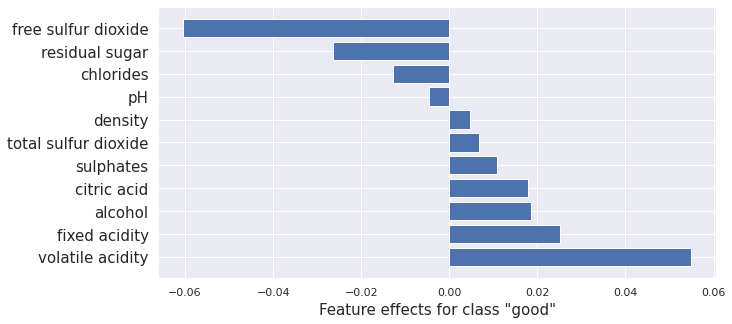
Kernel SHAP
Kernel SHAP is a method for computing the Shapley values of a model around an instance. Shapley values are a game-theoretic method of assigning payout to players depending on their contribution to an overall goal. In our case, the features are the players, and the payouts are the attributions.
Here we give an example of Kernel SHAP method applied to the Tensorflow model.
[14]:
from alibi.explainers import KernelShap
predict_fn = lambda x: model(scaler.transform(x))
explainer = KernelShap(predict_fn, task='classification')
explainer.fit(X_train[0:100])
result = explainer.explain(x)
plot_importance(result.shap_values[0], features, 0)
100%|██████████| 1/1 [00:00<00:00, 2.55it/s]
[14]:
(<AxesSubplot:xlabel='Feature effects for class 0'>,
<Figure size 720x360 with 1 Axes>)
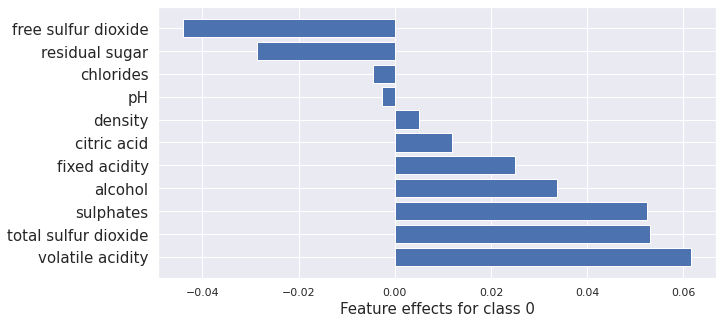
Here we apply Kernel SHAP to the Tree-based model to compare to the tree-based methods we run later.
[15]:
from alibi.explainers import KernelShap
predict_fn = lambda x: rfc.predict_proba(scaler.transform(x))
explainer = KernelShap(predict_fn, task='classification')
explainer.fit(X_train[0:100])
result = explainer.explain(x)
plot_importance(result.shap_values[1], features, '"Good"')
100%|██████████| 1/1 [00:00<00:00, 1.21it/s]
[15]:
(<AxesSubplot:xlabel='Feature effects for class "Good"'>,
<Figure size 720x360 with 1 Axes>)
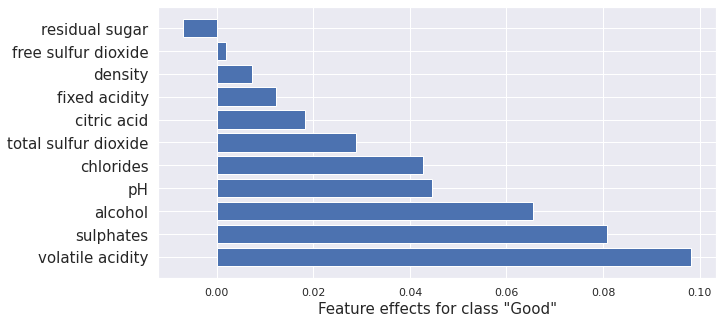
Interventional treeSHAP
Interventional tree SHAP computes the same Shapley values as the kernel SHAP method above. The difference is that it’s much faster for tree-based models. Here it is applied to the random forest we trained. Comparison with the kernel SHAP results above show very similar outcomes.
[16]:
from alibi.explainers import TreeShap
tree_explainer_interventional = TreeShap(rfc, model_output='raw', task='classification')
tree_explainer_interventional.fit(scaler.transform(X_train[0:100]))
result = tree_explainer_interventional.explain(scaler.transform(x), check_additivity=False)
plot_importance(result.shap_values[1], features, '"Good"')
[16]:
(<AxesSubplot:xlabel='Feature effects for class "Good"'>,
<Figure size 720x360 with 1 Axes>)
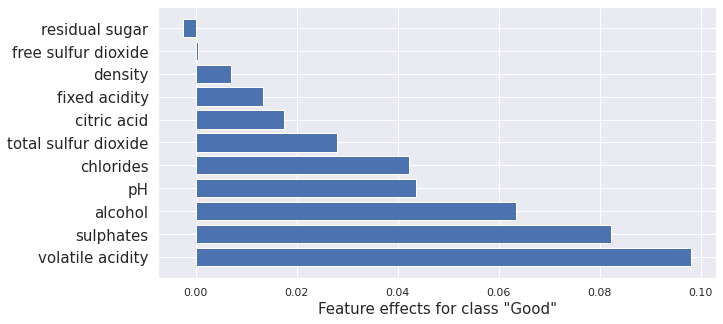
Path Dependent treeSHAP
Path Dependent tree SHAP gives the same results as the Kernel SHAP method, only faster. Here it is applied to a random forest model. Again very similar results to kernel SHAP and Interventional tree SHAP as expected.
[17]:
path_dependent_explainer = TreeShap(rfc, model_output='raw', task='classification')
path_dependent_explainer.fit()
result = path_dependent_explainer.explain(scaler.transform(x))
plot_importance(result.shap_values[1], features, '"Good"')
[17]:
(<AxesSubplot:xlabel='Feature effects for class "Good"'>,
<Figure size 720x360 with 1 Axes>)

Note: There is some difference between the kernel SHAP and integrated gradient applied to the TensorFlow model and the SHAP methods applied to the random forest. This is expected due to the combination of different methods and models. They are reasonably similar overall. Notably, the ordering is nearly the same.
Local Necessary Features
Anchors
Anchors tell us what features need to stay the same for a specific instance for the model to give the same classification. In the case of a trained image classification model, an anchor for a given instance would be a minimal subset of the image that the model uses to make its decision.
Here we apply Anchors to the tensor flow model trained on the wine-quality dataset.
[18]:
from alibi.explainers import AnchorTabular
predict_fn = lambda x: model.predict(scaler.transform(x))
explainer = AnchorTabular(predict_fn, features)
explainer.fit(X_train, disc_perc=(25, 50, 75))
result = explainer.explain(x, threshold=0.95)
The result is a set of predicates that tell you whether a point in the data set is in the anchor or not. If it is in the anchor, it is very likely to have the same classification as the instance x.
[19]:
print('Anchor =', result.data['anchor'])
print('Precision = ', result.data['precision'])
print('Coverage = ', result.data['coverage'])
Anchor = ['alcohol > 10.10', 'volatile acidity <= 0.39']
Precision = 0.9513641755634639
Coverage = 0.16263552960800667
Global Feature Attribution
ALE
ALE plots show the dependency of model output on a subset of the input features. They provide global insight describing the model’s behaviour over the input space. Here we use ALE to directly visualize the relationship between the TensorFlow model’s predictions and the alcohol content of wine.
[20]:
from alibi.explainers import ALE
from alibi.explainers.ale import plot_ale
predict_fn = lambda x: model(scaler.transform(x)).numpy()[:, 0]
ale = ALE(predict_fn, feature_names=features)
exp = ale.explain(X_train)
plot_ale(exp, features=['alcohol'], line_kw={'label': 'Probability of "good" class'})
[20]:
array([[<AxesSubplot:xlabel='alcohol', ylabel='ALE'>]], dtype=object)
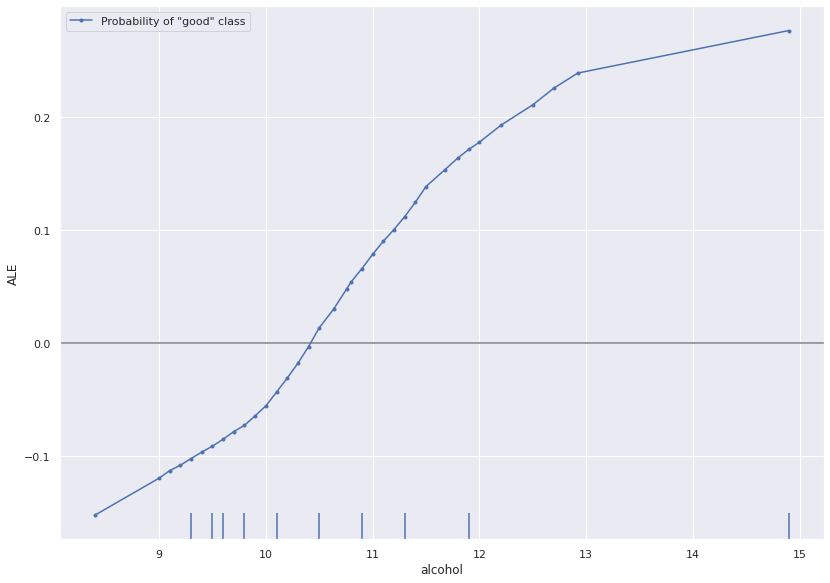
Counterfactuals
Next, we apply each of the “counterfactuals with reinforcement learning”, “counterfactual instances”, “contrastive explanation method”, and the “counterfactuals with prototypes” methods. We also plot the kernel SHAP values to show how the counterfactual methods change the attribution of each feature leading to the change in prediction.
Counter Factuals with Reinforcement Learning
CFRL trains a new model when fitting the explainer called an actor that takes instances and produces counterfactuals. It does this using reinforcement learning. In reinforcement learning, an actor model takes some state as input and generates actions; in our case, the actor takes an instance with a target classification and attempts to produce a member of the target class. Outcomes of actions are assigned rewards dependent on a reward function designed to encourage specific behaviors. In our case, we reward correctly classified counterfactuals generated by the actor. As well as this, we reward counterfactuals that are close to the data distribution as modeled by an autoencoder. Finally, we require that they are sparse perturbations of the original instance. The reinforcement training step pushes the actor to take high reward actions. CFRL is a black-box method as the process by which we update the actor to maximize the reward only requires estimating the reward via sampling the counterfactuals.
[21]:
from alibi.explainers import CounterfactualRL
predict_fn = lambda x: model(x)
cfrl_explainer = CounterfactualRL(
predictor=predict_fn, # The model to explain
encoder=ae.encoder, # The encoder
decoder=ae.decoder, # The decoder
latent_dim=7, # The dimension of the autoencoder latent space
coeff_sparsity=0.5, # The coefficient of sparsity
coeff_consistency=0.5, # The coefficient of consistency
train_steps=10000, # The number of training steps
batch_size=100, # The batch size
)
cfrl_explainer.fit(X=scaler.transform(X_train))
result_cfrl = cfrl_explainer.explain(X=scaler.transform(x), Y_t=np.array([1]))
print("Instance class prediction:", model.predict(scaler.transform(x))[0].argmax())
print("Counterfactual class prediction:", model.predict(result_cfrl.data['cf']['X'])[0].argmax())
100%|██████████| 10000/10000 [01:50<00:00, 90.18it/s]
100%|██████████| 1/1 [00:00<00:00, 167.78it/s]
Instance class prediction: 0
Counterfactual class prediction: 1
[22]:
cfrl = scaler.inverse_transform(result_cfrl.data['cf']['X'])
compare_instances(x, cfrl)
fixed acidity instance: 9.2 counter factual: 8.965 difference: 0.2350657
volatile acidity instance: 0.36 counter factual: 0.349 difference: 0.0108247
citric acid instance: 0.34 counter factual: 0.242 difference: 0.0977357
residual sugar instance: 1.6 counter factual: 2.194 difference: -0.5943643
chlorides instance: 0.062 counter factual: 0.059 difference: 0.0031443
free sulfur dioxide instance: 5.0 counter factual: 6.331 difference: -1.3312454
total sulfur dioxide instance: 12.0 counter factual: 14.989 difference: -2.9894428
density instance: 0.997 counter factual: 0.997 difference: -0.0003435
pH instance: 3.2 counter factual: 3.188 difference: 0.0118126
sulphates instance: 0.67 counter factual: 0.598 difference: 0.0718592
alcohol instance: 10.5 counter factual: 9.829 difference: 0.6712008
[23]:
from alibi.explainers import KernelShap
predict_fn = lambda x: model(scaler.transform(x))
explainer = KernelShap(predict_fn, task='classification')
explainer.fit(X_train[0:100])
result_x = explainer.explain(x)
result_cfrl = explainer.explain(cfrl)
plot_importance(result_x.shap_values[0], features, 0)
plot_importance(result_cfrl.shap_values[0], features, 0)
100%|██████████| 1/1 [00:00<00:00, 2.66it/s]
100%|██████████| 1/1 [00:00<00:00, 2.55it/s]
[23]:
(<AxesSubplot:xlabel='Feature effects for class 0'>,
<Figure size 720x360 with 1 Axes>)
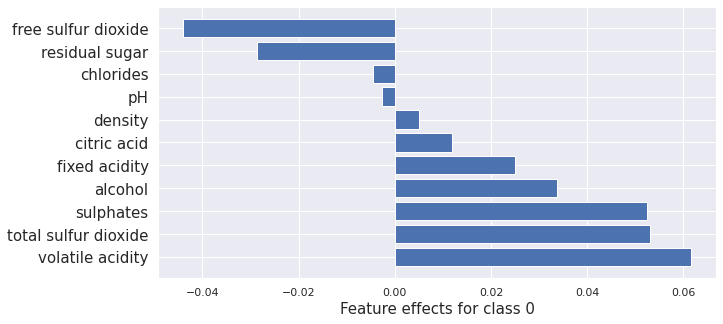

Counterfactual Instances
First we need to revert to using tfv1
[24]:
import tensorflow.compat.v1 as tf
tf.disable_v2_behavior()
WARNING:tensorflow:From /home/alex/miniconda3/envs/alibi-explain/lib/python3.8/site-packages/tensorflow/python/compat/v2_compat.py:111: disable_resource_variables (from tensorflow.python.ops.variable_scope) is deprecated and will be removed in a future version.
Instructions for updating:
non-resource variables are not supported in the long term
[25]:
from tensorflow.keras.models import Model, load_model
model = load_tf_model()
ae = load_ae_model()
WARNING:tensorflow:OMP_NUM_THREADS is no longer used by the default Keras config. To configure the number of threads, use tf.config.threading APIs.
WARNING:tensorflow:No training configuration found in the save file, so the model was *not* compiled. Compile it manually.
WARNING:tensorflow:No training configuration found in the save file, so the model was *not* compiled. Compile it manually.
The counterfactual instance method in alibi generates counterfactuals by defining a loss that prefers interpretable instances close to the target class. It then uses gradient descent to move within the feature space until it obtains a counterfactual of sufficient quality.
[26]:
from alibi.explainers import Counterfactual
explainer = Counterfactual(
model, # The model to explain
shape=(1,) + X_train.shape[1:], # The shape of the model input
target_proba=0.51, # The target class probability
tol=0.01, # The tolerance for the loss
target_class='other', # The target class to obtain
)
result_cf = explainer.explain(scaler.transform(x))
print("Instance class prediction:", model.predict(scaler.transform(x))[0].argmax())
print("Counterfactual class prediction:", model.predict(result_cf.data['cf']['X'])[0].argmax())
WARNING:tensorflow:From /home/alex/Development/alibi-explain/alibi/explainers/counterfactual.py:170: The name tf.keras.backend.get_session is deprecated. Please use tf.compat.v1.keras.backend.get_session instead.
`Model.state_updates` will be removed in a future version. This property should not be used in TensorFlow 2.0, as `updates` are applied automatically.
Instance class prediction: 0
Counterfactual class prediction: 1
[27]:
cf = scaler.inverse_transform(result_cf.data['cf']['X'])
compare_instances(x, cf)
fixed acidity instance: 9.2 counter factual: 9.23 difference: -0.030319
volatile acidity instance: 0.36 counter factual: 0.36 difference: 0.0004017
citric acid instance: 0.34 counter factual: 0.334 difference: 0.0064294
residual sugar instance: 1.6 counter factual: 1.582 difference: 0.0179322
chlorides instance: 0.062 counter factual: 0.061 difference: 0.0011683
free sulfur dioxide instance: 5.0 counter factual: 4.955 difference: 0.0449123
total sulfur dioxide instance: 12.0 counter factual: 11.324 difference: 0.6759205
density instance: 0.997 counter factual: 0.997 difference: -5.08e-05
pH instance: 3.2 counter factual: 3.199 difference: 0.0012383
sulphates instance: 0.67 counter factual: 0.64 difference: 0.0297857
alcohol instance: 10.5 counter factual: 9.88 difference: 0.6195097
[28]:
from alibi.explainers import KernelShap
predict_fn = lambda x: model.predict(scaler.transform(x))
explainer = KernelShap(predict_fn, task='classification')
explainer.fit(X_train[0:100])
result_x = explainer.explain(x)
result_cf = explainer.explain(cf)
plot_importance(result_x.shap_values[0], features, 0)
plot_importance(result_cf.shap_values[0], features, 0)
100%|██████████| 1/1 [00:01<00:00, 1.19s/it]
100%|██████████| 1/1 [00:01<00:00, 1.23s/it]
[28]:
(<AxesSubplot:xlabel='Feature effects for class 0'>,
<Figure size 720x360 with 1 Axes>)
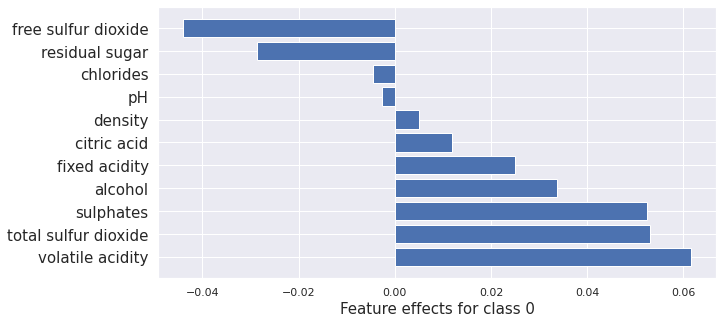

Contrastive Explanations Method
The CEM method generates counterfactuals by defining a loss that prefers interpretable instances close to the target class. It also adds an autoencoder reconstruction loss to ensure the counterfactual stays within the data distribution.
[29]:
from alibi.explainers import CEM
cem = CEM(model, # model to explain
shape=(1,) + X_train.shape[1:], # shape of the model input
mode='PN', # pertinant negative mode
kappa=0.2, # Confidence parameter for the attack loss term
beta=0.1, # Regularization constant for L1 loss term
ae_model=ae # autoencoder model
)
cem.fit(
scaler.transform(X_train), # scaled training data
no_info_type='median' # non-informative value for each feature
)
result_cem = cem.explain(scaler.transform(x), verbose=False)
cem_cf = result_cem.data['PN']
print("Instance class prediction:", model.predict(scaler.transform(x))[0].argmax())
print("Counterfactual class prediction:", model.predict(cem_cf)[0].argmax())
Instance class prediction: 0
Counterfactual class prediction: 1
[30]:
cem_cf = result_cem.data['PN']
cem_cf = scaler.inverse_transform(cem_cf)
compare_instances(x, cem_cf)
fixed acidity instance: 9.2 counter factual: 9.2 difference: 2e-07
volatile acidity instance: 0.36 counter factual: 0.36 difference: -0.0
citric acid instance: 0.34 counter factual: 0.34 difference: -0.0
residual sugar instance: 1.6 counter factual: 1.479 difference: 0.1211611
chlorides instance: 0.062 counter factual: 0.057 difference: 0.0045941
free sulfur dioxide instance: 5.0 counter factual: 2.707 difference: 2.2929246
total sulfur dioxide instance: 12.0 counter factual: 12.0 difference: 1.9e-06
density instance: 0.997 counter factual: 0.997 difference: -0.0004602
pH instance: 3.2 counter factual: 3.2 difference: -0.0
sulphates instance: 0.67 counter factual: 0.549 difference: 0.121454
alcohol instance: 10.5 counter factual: 9.652 difference: 0.8478804
[31]:
from alibi.explainers import KernelShap
predict_fn = lambda x: model.predict(scaler.transform(x))
explainer = KernelShap(predict_fn, task='classification')
explainer.fit(X_train[0:100])
result_x = explainer.explain(x)
result_cem_cf = explainer.explain(cem_cf)
plot_importance(result_x.shap_values[0], features, 0)
plot_importance(result_cem_cf.shap_values[0], features, 0)
100%|██████████| 1/1 [00:01<00:00, 1.22s/it]
100%|██████████| 1/1 [00:01<00:00, 1.21s/it]
[31]:
(<AxesSubplot:xlabel='Feature effects for class 0'>,
<Figure size 720x360 with 1 Axes>)


Counterfactual With Prototypes
Like the previous two methods, “counterfactuals with prototypes” defines a loss that guides the counterfactual towards the target class while also using an autoencoder to ensure it stays within the data distribution. As well as this, it uses prototype instances of the target class to ensure that the generated counterfactual is interpretable as a member of the target class.
[32]:
from alibi.explainers import CounterfactualProto
explainer = CounterfactualProto(
model, # The model to explain
shape=(1,) + X_train.shape[1:], # shape of the model input
ae_model=ae, # The autoencoder
enc_model=ae.encoder # The encoder
)
explainer.fit(scaler.transform(X_train)) # Fit the explainer with scaled data
result_proto = explainer.explain(scaler.transform(x), verbose=False)
proto_cf = result_proto.data['cf']['X']
print("Instance class prediction:", model.predict(scaler.transform(x))[0].argmax())
print("Counterfactual class prediction:", model.predict(proto_cf)[0].argmax())
`Model.state_updates` will be removed in a future version. This property should not be used in TensorFlow 2.0, as `updates` are applied automatically.
Instance class prediction: 0
Counterfactual class prediction: 1
[33]:
proto_cf = scaler.inverse_transform(proto_cf)
compare_instances(x, proto_cf)
fixed acidity instance: 9.2 counter factual: 9.2 difference: 2e-07
volatile acidity instance: 0.36 counter factual: 0.36 difference: -0.0
citric acid instance: 0.34 counter factual: 0.34 difference: -0.0
residual sugar instance: 1.6 counter factual: 1.6 difference: 1e-07
chlorides instance: 0.062 counter factual: 0.062 difference: 0.0
free sulfur dioxide instance: 5.0 counter factual: 5.0 difference: 0.0
total sulfur dioxide instance: 12.0 counter factual: 12.0 difference: 1.9e-06
density instance: 0.997 counter factual: 0.997 difference: -0.0
pH instance: 3.2 counter factual: 3.2 difference: -0.0
sulphates instance: 0.67 counter factual: 0.623 difference: 0.0470144
alcohol instance: 10.5 counter factual: 9.942 difference: 0.558073
[34]:
from alibi.explainers import KernelShap
predict_fn = lambda x: model.predict(scaler.transform(x))
explainer = KernelShap(predict_fn, task='classification')
explainer.fit(X_train[0:100])
result_x = explainer.explain(x)
result_proto_cf = explainer.explain(cem_cf)
plot_importance(result_x.shap_values[0], features, 0)
print(result_x.shap_values[0].sum())
plot_importance(result_proto_cf.shap_values[0], features, 0)
print(result_proto_cf.shap_values[0].sum())
100%|██████████| 1/1 [00:01<00:00, 1.20s/it]
100%|██████████| 1/1 [00:01<00:00, 1.25s/it]
0.16304971136152735
-0.20360063157975683
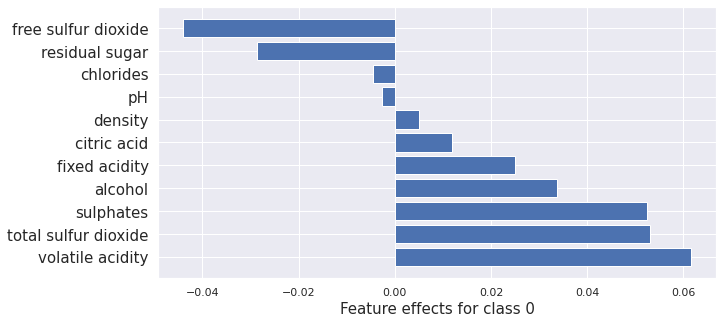
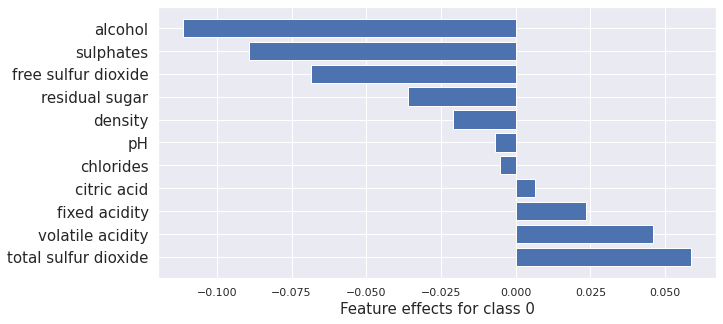
Looking at the ALE plots below, we can see how the counterfactual methods change the features to flip the prediction. Note that the ALE plots potentially miss details local to individual instances as they are global insights.
[35]:
plot_ale(exp, features=['sulphates', 'alcohol', 'residual sugar', 'chlorides', 'free sulfur dioxide', 'total sulfur dioxide'], line_kw={'label': 'Probability of "good" class'})
[35]:
array([[<AxesSubplot:xlabel='sulphates', ylabel='ALE'>,
<AxesSubplot:xlabel='alcohol', ylabel='ALE'>,
<AxesSubplot:xlabel='residual sugar', ylabel='ALE'>],
[<AxesSubplot:xlabel='chlorides', ylabel='ALE'>,
<AxesSubplot:xlabel='free sulfur dioxide', ylabel='ALE'>,
<AxesSubplot:xlabel='total sulfur dioxide', ylabel='ALE'>]],
dtype=object)
